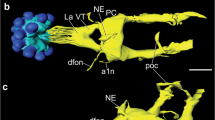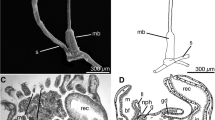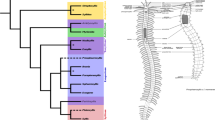Abstract
The present review summarizes the literature and provides new data concerning nervous system structure and the identification of individual neurons in the snail Helix lucorum. Information about especially well-known neurons is provided in a table, and maps of the identifiable neuron's location in ganglia are correlated with the results of retrograde staining via various cerebral and subesophageal nerves. References concerning the morphology of snail central nervous system and identifiable neurons are given.
Similar content being viewed by others
References
G. G. Arakelov and T. A. Sakharova, “Structure-functional analysis of identified neurons in snails,”Zh. Vyssh. Nervn. Dyat.,26, No. 6, 1180–1187 (1979).
G. G. Arakelov and E. D. Shekhter, “Giant polyfunctional neuron in terestrial snails,”Zh. Vyssh. Nervn. Dyat.,31, No. 1, 96–105 (1981).
V. P. Babmindra, V. L. Xhuravlev, I. N. Pavlenko, and T. A. Saphonova et al., “Identification of snail neurons by peroxidase method,”Dokl. Akad. Nauk SSSR,245, No. 3, 743–745 (1979).
P. M. Balaban, E. G. Litvinov, “Command neurons in reflex arc of unconditioned reflex of the snail,”Zh. Vyssh. Nervn. Deyat.,27, 538–544 (1977).
P. M. Balaban, O. A. Maksimova, I. S. Zakharov, and V. N. Matz, “Electrophysiological characteristics of identifiable neurons in snailHelix lucorum,”Zh. Évol. Biokhim. Physiol.,17, No. 4, 366–371 (1981).
P. M. Balaban, I. S. Zakharov, and V. N. Matz, “Selective vital staining of serotonergic cells 5,7dihydroxytryptamine,”Dokl. Akad. Nauk SSSR,283, 735–738 (1985).
P. M. Balaban and R. Chase, “Interrelations of emotionally positive and negative brain zones in the snail,”Zh. Vyssh. Nervn. Deyat.,40, No. 1, 125–134 (1977).
P. M. Balaban, N. I. Bravarenko, and I. S. Zakharov, “Neurochemical base of recurrent inhibition in the reflex pathway underlying withdrawal,”Zh. Vyssh. Nervn. Devat.,41, No. 5, 1060–1065 (1991).
G. N. Galanina, I. S. Zakharov, O. A. Maximova, and P. M. Balaban, “Role of giant serotonergic cell of the snail cerebral ganglia in feeding behavior,”Zh. Vyssh. Nervn. Deyat.,36, No. 1, 110–116 (1991).
V. A. Dyatlov and A. V. Platoshin, “Subsynaptic modulation by metacerebral neurons of a chemical transmission of excitation in buccal ganglia of mollusc,”Neirophysiologiya,21, No. 4, 539–546 (1989).
I. S. Zakharov, V. N. Matz, and P. M. Balaban, “Participation of giant cerebral neuron in control of withdrawal behavior in the snail,”Neirophysiologiya,14, 353–358 (1982).
N. I. Kononenko, “Variability of electrical activity in neuron RPal of the snail,”Neirophysiologiya,13, No. 4, 398–404 (1981).
N. I. Kononenko and O. N. Osipenko, “Different effects of stimulation of peptidergic neuron on postsynaptic cells in CNS of snails,”Dokl. Akad. Nauk SSSR,306, 236–239 (1989).
P. D. Lisachev and V. P. Tretyakov, “Structural basis of organization of motor program of avoidance reflex in snails,” in:Simple Nervous Systems (Abstracts), Leningrad, Nauka, (1988), p. 167–169.
P. D. Lisachev and V. P. Tretyakov, “Distribution of axons of neurons LPa3 and RPa3 in the nerves of pedal ganglia in snails,”Zh. Vyssh. Nervn. Deyat.,38, No. 6, 1132–1137 (1988).
O. A. Maksimova and P. M. Balaban,Neural Mechanisms of Behavioral Plasticity [in Russian], Nauka, Moscow (1983).
Ph. I. Samygin and L. D. Karpenko, “Localization of neurons innervating columellar muscles in snails,”Neirophysiologiya,12, 637–641 (1980).
D. A. Sakharov,Genealogy of Neurons [in Russian], Nauka, Moscow (1974).
T. Bang, “Zur morphologie des nervensystems vonHelix pomatia L.,”Zool. Anzeiger.,48, No. 9, 281–291 (1917).
P. M. Balaban, “Postsynaptic mechanisms of withrawal reflex sensitization in the snail,”J. Neurobiology,14, No. 5, 365–375 (1983).
P. M. Balaban and R. Chase, “Inhibition of cells involved in avoidance behavior by stimulation of mesocerebrum,”A. Comp. Physiol.,166, No. 3, 421–427 (1990).
T. H. Bullock, “The problem of recognition in an analyzer made of neurons,” in:Sensory Communications, W. A. Rosenblith (ed.), MIT Press, Cambridge (1961), p. 714–724.
R. Chase, “Brain cells that command sexual behavior in the snailHelix aspersa,”J. Neurobiol.,17, No. 6, 669–697 (1986).
G. A. Cottrell and J. B. Macon, “Synaptic connections of two symmetrically placed giant serotonin-containing neurons,”J. Physiol.,236, No. 2, 435–464 (1974).
N. T. Davis, “Improved methods for cobalt filling and silver intensification of insect motor neurons,”Stain Technol.,57, No. 3, 239–244 (1982).
R. C. Eaton and R. DiDomenico, “Command and the neural causation of behavior: A theoretical analysis of the necessity and sufficiency paradigm,”Brain, Behav. Evol.,27, No. 2, 132–164 (1985).
B. Eberhardt and R. W. Wabnitz, “Morphological identification and functional analysis of central neurons innervating the penis retractor muscle ofHelix pomatia,”Comp. Biochem. Physiol.,63A, No. 5, 599–613 (1979).
K. Elekes, L. Hernadi, and G. Kemenes, “Serotonin immunoreactive neurons in the CNS ofHelix andLymnaea,” in:Neurobiology of Invertebrates. Transmitters, Modulators and Receptors, J. Salanki, K. S. Rosza (eds). Budapest, Academial Kiado, 703–713 (1988).
K. Elekes and D. R. Nassel, “Distribution of FMRFamide-like immunoreactive neurons in the central nervous system of snailHelix pomatia,”Cell Tissue Res.:262, No. 1, 177–190 (1990).
L. Hernadi, G. Kemenes, and J. Salanki, “Central representation and functional connections of afferent and efferent pathways ofHelix pomatia L lip nerves,”Acta Biol. Acad. Sci Hung.,35, No. 1, 49–69 (1984).
G. Hoyle, “Generation of behavior: the orchestration hypothesis,” in:Feedback and Motor Control in Invertebrates and Vertebrates, W. J. P. Barnesa and M. H. Gladden (eds.), London, Groom Helm (1985), p. 5775.
V. N. Ierusalimsky and P. M. Balaban, “Functioning of identified snail neurons in electric fields,”J. Exp. Biol.,131, No. 1, 17–36 (1987).
E. R. Kandel and L. Tauc, “Input organization of two symmetrical giant cells in the snail brain,”J. Physiol.,183, No. 1, 269–286 (1966).
E. R. Kandel and I. Kupfermann, “The functional organization of invertebrate ganglia,”Ann. Rev. Physiol.,32, 193–258 (1970).
G. Kemenes, A. Vehovszky, I. Zakharov, and K. S. Rozsa, “Neuroethological analysis of the pneumostome opening involved into whole-body eversion ofHelix pomatia L.,” in:Neural Mechanisms of Behavior. Proceedings of the 2-nd Int. Congr. of Neuroethol., J. Erber, R. Menzel, H.-J. Pflunger et al. (eds.), Stuttgart, New York, Georg Thieme Verlag (1989), p. 50.
D. Kennedy, “Cryfish interneurons,”Physiologist,14, No. 1, 5–50 (1971).
G. A. Kerkut, J. D. C. Lambert, R. J. Gayton, J. E. Loker, et al., “Mapping of nerve cells in the suboesophageal ganglia ofHelix aspersa,”Comp. Biochem. Physiol.,50A, No. 1, 1–25 (1975).
H. Kunze, “Uber den Aufban des Centralnervensystems vonHelix pomatia L. und die Struktur seiner elemente,”Zool. Anzeiger.,48, No. 8, 232–240 (1917).
H. Kunze, “Uber des standige Auftretken Bestimmter Zellelemente im Centralnervensystem vonHelix pomatia L.,”Zool. Anzeiger.,49, No. 1, 123–137 (1918).
I. Kupfermann and K. R. Weiss, “The command neuron concept,”Behav. Brain Sci.,1, No. 1, 3–20 (1978).
M. Leon-Olea, M. Sanchez-Alvarez, F. Camacho, and F. J. Alvarez-Leefmans, “Distribution and seasonal variations of the immunoreactivity to Leu- and Met- enkephalins in the periesophageal ganglia of the snailHelix aspersa,”Neurosci. Abstr., No. 385 (1991), p. 18.
A. D. McClellan, “Command systems for initiating locomotion in fish and amphibians: Parallels to initiation systems in mammals,” in:Neurobiology of Vertebrate Locomotion, H. Grillner, S. Stein (eds), MacMillan Press, New York (1986), p. 3–20.
N. J. Strausfeld and T. A. Miller (eds),Neuroanatomical Techniques. Insect Nervous System, Heidel berg-Springer-Verlag, New York-Berlin (1980).
L. Heimer and L. Zaborszky (eds),Neuroanatomical-Tract Tracing Methods. 2, Plenum Publishing Corporation, New York (1989).
M. Pasic, D. Zecevic, and D. Ristanovic, “Prolonged effects of electrical stimulation of the peripheral nerves on a bursting neuron in the snail ganglion,” inNeurobiology of Invertebrates. Gastropoda Brain, J. Salanki (ed), Budapest, Akademiai Kiado, (1976), p. 547–560.
V. W. Pentreath, N. N. Osborne, and G. A. Cottrell, “Anatomy of giant serotonin containing neurons in the cerebral ganglia ofHelix pomatia andLimax maximus,” Z. Zellforsch.,143, No. 1, 1–20 (1973).
J. Pusztai, L. Detari, and G. Szenasi, “Electrophysiological and morphological characteristics of neurons of the snail,Helix pomatia L.,” inNeurobiology of Invertebrates. Gastropoda Brain, J. Salanki (ed), Budapest, Akademii Kiado (1976), p. 111–121.
D. A. Sakharov and J. Salanki, “Physiological and pharmacological identification of neurons in the central nervous system ofHelix pomatia L.,”Acta Physiol. Hung.,35, No. 1, 19–30.
E. Schmalz, “Zur Morphologie des Nervensystem vonHelix pomatia,”Zeit. Wissenshaften. Zool.,111, 509–568 (1914).
R. W. Sperry, “A modified concept of consciousness,”Physiol. Rev,76, 532–536 (1969).
K. S., Rozsa and J. Salanki, “Responses of central neurones to the stimulation of heart chemoreceptors in the snail,Helix pomatia L.,”Ann. Biol. Tihany.,40, No. 1, 95–108 (1973).
K. S. Rozsa, “Neuronal network underlying the regulation of heart beat inHelix pomatia L.,” in:Neurobiology of Invertebrates. Gastriopoda Brain, J. Salanki (ed), Budapest, Akademiai Kiado (1976), p. 597–613.
Van H. Wilsenburg and J. V. Milligan, “Neurons in the suboeesophageal ganglion complex of the snail,Helix pomatia, having a functional relation to cardio-respiratory activity,” in:Neurobiology of Invertebrates. Gastropoda Brain. J. Salanki (ed), Budapest, Akademiai Kiado (1976), p. 615–627.
W. Winlow and N. I. Syed, “Modulation of behavior by a multiganglionic neuronal ensemble,” in:Signal Molecules and Behavior, W. Winlow, O. S. Vinogradova, and D. A. Sakharov (eds), Manchester University Press, Manchester-New York (1991), p. 85–100.
A. Vehovszky, G. Kemenes, and K. S. Rozsa, “Central and peripheral connections of an identified pedal neuron modifying pneumostome movements inHelix,”Comp. Biochem. Physiol.,94A, No. 6, 735–741 (1989).
C. A. G. Wiersma, “Function of the giant fibers of the central nervous system of the crayfish,”Proc. Soc. Exper. Biol. Med.,38, No. 4, 661–661 (1938).
C. A. G. Wiersma, “Neurons of arthropods,” Cold Spring Harbor Symp. Quant. Biol.,17, 155–163 (1952).
C. A. G. Wiersma, and K. Ikeda, “Interneurons commanding swimmeret movements in the crayfishProcambarus clarkii (Girard),”Comp. Biochem. Physiol.,12, No. 4, 509–525 (1964).
P. Weiss, “1+1=2 (When one plus one does not equal two),” in:The Neuroscience: A Study Program, Rockefeller Press, New York (1967), p. 801–832.
J. Z. Young, “The functioning of the giant nerve fibers of the squid,”J. Exptl. Biol.,15, No. 1, 170–185 (1938).
I. S. Zakharov, and P. M. Balaban, “Serotonergic modulation of avoidance behavior inHelix,” in:Simpler Nervous Systems, D. A. Sakharov, W. Winlow(eds.), Manchester University Press, Manchester-New York (1991), p. 316–329.
Author information
Authors and Affiliations
Additional information
Translated from Zhurnal Vysshei Nervnoi Deyatel'nosti imeni I. P. Pavlova, Vol. 42, No. 6, pp. 1075–1089, November–December, 1992.
Translated by P. M. Balaban.
Rights and permissions
About this article
Cite this article
Ierusalimsky, V.N., Zakharov, I.S., Palikhova, T.A. et al. Nervous system and neural maps in gastropodHelix lucorum L.. Neurosci Behav Physiol 24, 13–22 (1994). https://doi.org/10.1007/BF02355648
Received:
Revised:
Issue Date:
DOI: https://doi.org/10.1007/BF02355648




